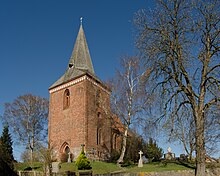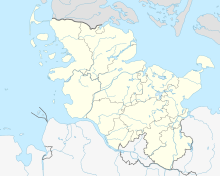Maria Magdalenen Church (Berkenthin)
The Evangelical Lutheran Maria Magdalenen Church in Berkenthin is located on a hill in the center of the village near the banks of the Elbe-Lübeck Canal .
Church construction and history
The church in Berkenthin was built around 1250. The parish belonging to it was probably founded around 1195; its existence is documented in the Ratzeburg tithe register from 1230. The architectural style of the oldest parts of the church corresponds to the transition from the Romanesque style to the Gothic style , which can be found in many churches in the Duchy of Lauenburg .
The nave is now a rectangular brick building , on the lower parts of which there is still old field stone masonry. The choir has a simple, straight end and on the north side a sacristy was added in 1900 . The nave shows traces of an original plan for a vaulted ceiling, which however never came to fruition as planned. Until the beginning of the 20th century, the nave had a flat wooden ceiling. The church tower, which is large in relation to the rest of the building, was probably already in place in the 13th century, as was the stone vault above the choir.
The masonry suggests that the church was destroyed several times. There are no records of this. All that is known is that a lightning strike in 1816 largely destroyed the church tower and almost completely had to be rebuilt. A construction with four gables and a small wooden tower was built, but it was not very stable and was replaced in 1867 by today's pointed church tower. Since the overall structural condition of the church was not in good shape, it was decided to carry out a general restoration, which began in 1899. In the course of this, the nave was changed on the basis of the original plan and two stone ribbed vaults were constructed in place of the flat ceiling.
The first record of a Lutheran pastor in Berkenthin can be found in 1538 .
Naming
For much of its history, the church is usually referred to simply as the "Church in Berkenthin". In documents from the 16th and 17th centuries, it is referred to as consecrated to Maria Magdalena . This connection seems consistent, since the Berkenthiner Church was one of the churches of the Stecknitz drivers who had chosen Maria Magdalena as patron saint . According to other documents from 1832, it was consecrated to the Apostle Peter , who is represented twice in the church.
Since March 2nd, 2008 the church has been officially named "Maria Magdalena Church".
Furnishing
In the interior, the large number of pictures on the walls is particularly striking. During the restoration in 1899, old wall paintings were discovered under the plaster, which were restored and supplemented with new paintings. The church today has a mixture of medieval and medieval wall paintings. The oldest wall paintings are on the west gallery in the nave and on the arched wall of the choir. The entire interior and furnishings were last renovated in 1982.
The altar, the pulpit from 1696, the galleries and the stalls show the elaborate style of the baroque .
A crucifix dated to the late 14th century , depicting Christ on a tree trunk cross, hangs over the passage to the sacristy. The baptismal angel dates from 1734 and was still used in the 20th century. A striking and unusual piece is the large wooden statue of Mary Magdalene from the 15th century.
Bells
There are two bells in the tower that Friedrich Wilhelm Hirt cast in 1817.
organ
Today's organ was built in 1973 by the organ builder Klaus Becker . It is not particularly extensive with 13 registers , its disposition is as follows:
|
|
|
|||||||||||||||||||||||||||||||||||||||||||||||||
- Coupling : II / I, I / P, II / P
Churchyard
The area around the church served as a cemetery until 1885 . Until 1907, the city of Lübeck held rights to grave sites for the Stecknitz drivers, some of which are still preserved today. There are also some scattered old tombstones, memorials for the victims of the world wars and two memorial plaques on the outside of the church. The Berkenthin cemetery has been located on the opposite west side of the Elbe-Lübeck Canal since the 1880s.
Photographs and map
Coordinates: 53 ° 43 ′ 48 " N , 10 ° 38 ′ 50" E
literature
- Hermann Augustin (Hrsg.): Country, hear the Lord's word: Ev.-luth. Church and churches in the Duchy of Lauenburg . Schmidt-Römhild, Lübeck 1984, ISBN 3-7950-0700-3 , p. 259-264 .
- Dirk Jonkanski, Lutz Wilde : Village churches in Schleswig-Holstein . Wachholtz, Neumünster 2000, ISBN 3-529-02845-2 , pp. 35, 66, 108, 123 .
Individual evidence
- ^ Name and address of the church on the website of the north church . Retrieved December 18, 2018.
- ↑ a b c d e f Timeline of the development of the church in Hermann Augustin (ed.): Land, hear the Lord's word: Ev.-luth. Church and churches in the Duchy of Lauenburg . Schmidt-Römhild, Lübeck 1984, ISBN 3-7950-0700-3 , p. 264 .
- ↑ a b c Jonkanski, Wilde: village churches in Schleswig-Holstein . S. 35 .
- ↑ a b c d e history of the church on the website for the history of the neighboring town of Rondeshagen. Retrieved December 18, 2018.
- ↑ On the website for the history of Rondeshagen there is a drawing of the old tower from 1816. There, however, 1967 is given as the year of reconstruction to the current state, whereas Augustin, p. 263 states 1867 as the year of reconstruction. The second statement is supported by an aerial photo in the photo gallery of the church 's friends' association , which is dated "ca 1950" and shows the current tower.
- ^ Hermann Augustin (Ed.): Land, hear ... Schmidt-Römhild, Lübeck 1984, ISBN 3-7950-0700-3 , p. 304 .
- ↑ In Hermann Augustin (Ed.): Land, hear ... Schmidt-Römhild, Lübeck 1984, ISBN 3-7950-0700-3 , p. 296 . the church is called the "Maria Magdalenen Church" for the year it was founded.
- ↑ Information about the Stecknitz drivers on the page on the history of the municipality of Rondeshagen. Retrieved December 14, 2018.
- ↑ a b Joachim Strunk: In the "most beautiful church in the world" . In: Lübecker Nachrichten . December 8, 2016 ( online [accessed December 18, 2018]).
- ↑ Jonkanski, Wilde: village churches in Schleswig-Holstein . S. 66 .
- ↑ Entry in the organ database orgbase.nl : Retrieved on December 3, 2018.
- ↑ Jonkanski, Wilde: village churches in Schleswig-Holstein . S. 123 .
- ^ Representation of the cemetery on the website of the parish Berkenthin. Retrieved December 14, 2018.
Web links
- Homepage of the parish









